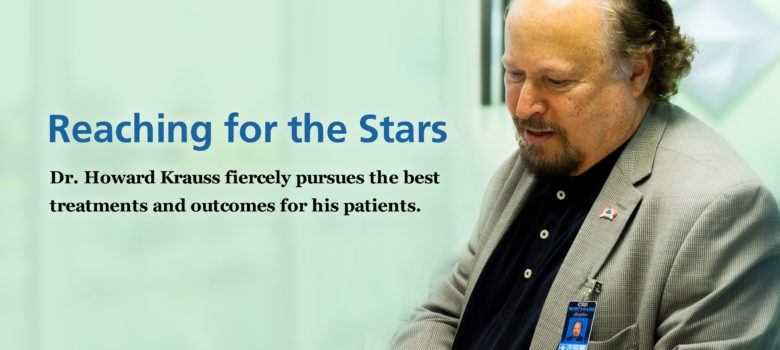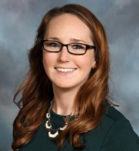

PHYSICIAN SPOTLIGHT: Dr. Howard R. Krauss – A Unique Perspective
by Karter White
Howard R. Krauss is a bit of an enigma. Appearing stern at first, his subtle humor slowly becomes apparent. He is like a book filled with treasures that reveal his depth of knowledge as a physician and surgeon who is fiercely dedicated to his patients. Dr. Krauss is a neurosurgical ophthalmologist with his own thriving private practice in West Los Angeles. He is one of the co-founders of the Pacific Neuroscience Institute and is co-director of the Pacific Eye, Ear & Skull Base Center.
Dr. Krauss was appointed to the Medical Board of California by Governor Jerry Brown in 2013 and continues to serve in that capacity having been reappointed by the Governor this week. He is a founding member and past board member of the North American Skull Base Society and serves on the board of directors for the California Ambulatory Surgery Association. He is a past President of the California Academy of Eye Physicians & Surgeons and the Los Angeles County Medical Association.
Dr. Krauss sat down with us to talk about his philosophy of patient care, the expanding field of the neurosciences and more. Here is what he had to say.
* * *
We Have Lift-Off
I had a natural proclivity to mathematics, and the US-manned space flight program began during my grade school days. I loved reading science fiction – I loved imagining other planets, other civilizations, and pondering the universe. When I was in sixth grade, I was quite certain that I would be an aerospace engineer. So indeed, I have a bachelor’s in electrical engineering, a master’s degree in aeronautics and astronautics, and then I went to work for the Hughes Aircraft Company designing communications systems for spacecraft and satellites.
What I recognized soon after is that there was a hole, something missing.
Seeing Is Believing
What was missing was something more humanistic in my life. So while I was working as an engineer in the daytime, I went to UCLA extension in the evening to take pre-med classes. My wife Cheryl married me three weeks before I started medical school and has been my biggest fan and even bigger supporter ever since then, and she’s helped further my career.
When I began medical school with the background and bias of an electrical engineer, I viewed the most important organ of our body to be our brain. It’s the most intriguing and it’s as difficult to fathom as the universe. Therefore, as a young medical student, I dedicated myself to the brain, thinking perhaps I would be a neurosurgeon or a neurologist. But at that time, I also discovered that 40% of our brain is involved with vision. So both in terms of an emotional connection and an academic interest, I determined then that I would be a neuro-ophthalmologist.
The pathway to that was to pursue postgraduate training in ophthalmology after medical school, surgical training and then fellowship training in neurosurgical ophthalmology. I had an early academic career at Southwestern Medical School but quickly decided to devote myself to clinical practice.
If I reflect back to the early years, I loved writing. Recently, I discovered a long forgotten short story that I had written and was published in my Junior High yearbook about brothers on a bicycle built for two. You read that the brother in the back of the bicycle is sightless, but as time progresses he has a spontaneous recovery of vision. You learn that at the young age of three, he was alone in the car with his mother when unfortunately he witnessed her pass away from a fatal car accident. Here I was 12 years of age, knowing I would be an aerospace engineer, writing stories about the brain, about the psychological aspects of the brain, about hysterical blindness and basically, about neuro-ophthalmology. So although I have a very clear intellectual pathway to how I became what I am today, I like to think that there was always a neuro-ophthalmologist trapped inside me that finally found his way out.
Saint John’s Becomes The Place To Be
I’ve always admired Saint John’s. From the days of my residency when I had the opportunity to work not only with full-time faculty but clinical faculty, it was evident to me that Saint John’s has always had an incredible community of physicians.
Even in the region of eye research and eye surgical developments, no one would think to imagine that the leading research and clinical and surgical developments in eye care were happening at Saint John’s in the 1970s and 1980s. That’s where I met the late ophthalmic pioneer, Dr. Robert Sinskey who was doing his groundbreaking work at Saint John’s. When I decided to enter clinical practice, there was no doubt that the place that I wanted to be was Saint John’s. And Saint John’s has continued to live up to that reputation in terms of attracting, supporting and maintaining the best clinicians.
Joining Together with the Band
I’d been active on the clinical faculty teaching and taking care of patients at UCLA where I first met Dr. Daniel Kelly. When I joined the Santa Monica community, soon thereafter, I met Dr. Chester Griffiths who is one of the finest ear, nose & throat and head and neck surgeons I have ever collaborated with. So when you have the karma and the benefit of meeting somebody spectacular, my recommendation is to hold on to them and build something with them. And that’s exactly what we’ve done.
Pacific Neuroscience Institute Emerges
I’ve known Dr. Kelly for almost a quarter of a century. I met him when he was recruited by UCLA to head up their pituitary tumor program and I’ve worked closely with him since that time. I must admit, when Dr. Kelly was unable to build his program coincident with his grand vision, Dr. Griffiths and I were co-conspirators who enticed him to come to Saint John’s.
It’s not just the nucleus of the Saint John’s physician community or the physical location in lovely Santa Monica that are attractive, it is also that we have incredible support at all levels from the administration, Saint John’s Foundation, and now our new partner, Providence Health & Services for what we see as our mission of helping patients. Our supporters are critically important to helping us further accelerate our mission and without their help we could not achieve what we want to accomplish.
Well of course, I have to thank Dr. Dan Kelly because over the past decade since he has been at Saint John’s, he has accomplished incredible things – he has inspired us and given us the opportunity to build the Pacific Neuroscience Institute.
One of the things I’ve learned in my education and my career is that no matter how good any one of us may be individually, that if you can form a group of physicians of multiple specialties who are collaborative and all focused on the patient rather than on themselves and their own career development, that the ability to accelerate research and bring new methodologies of new patient care forward is greatly enhanced. And that’s exactly what we have with PNI. It’s led by Dr. Kelly, but he will be the first to tell you that it’s not about him, it’s not about me, it’s about what we’re building together and how that’s going to help our patients.
Bringing A Unique Perspective to Patients’ Lives
I’m still an engineer, so the good news and the bad news is I think like an engineer. Historically in my practice, the patients with difficult to figure out problems are the ones that have been referred to me by my colleagues. I have had the joy and pleasure of figuring out what’s wrong and in most cases, I’ve helped them recover. I’m a bit biased but I think that medicine is best served by having physicians from a multiplicity of backgrounds. Bringing all of that talent, diversity and varied experience into medicine rather than thinking that there’s just one committed pathway to becoming a doctor makes for a richer and deeper understanding of patients and how to treat them.
I’ve had the great fortune of melding an engineering mind with a physician’s mind. Dr. Griffiths, Dr. Kelly and I have developed new surgical techniques that have been very helpful to people, treating things that had been thought in the past to be untreatable. It’s a great opportunity for us to collaborate and work together in the best possible way to find new methods of helping our patients.
Stepping Out Into the Future
One way to think about where we are going in the future is to reflect on where we were 10 or 20 years ago. And quite frankly, we wouldn’t have predicted the great things that we’re accomplishing today. With my co-founders, Dr. Kelly, Dr. Griffiths and Dr. Santosh Kesari, we are each contributing something that we couldn’t have imagined in terms of minimally invasive surgery, novel diagnostics, and precision treatment for brain cancer.
If I speculate as to where we will be in 10-20 years, I may be wrong. But the research that we are doing now stimulates us to believe that we’ll have better and better treatments for brain cancer and even if it isn’t curable, it will hopefully become a chronic disease rather than a fatal one.
Moreover, we are on the threshold of greater use of bioelectronics. We have a deep brain stimulation program for the treatment of Parkinson’s disease and other movement disorders; there are exciting things on the horizon in the way of integrating electronic implants in the brain to restore vision for people who have lost eye sight and to restore other neurologic function; there are treatments in development for regeneration and restoration of brain function for people who have had brain damage from injuries and strokes.
Repairing the brain and protecting the brain are what we are about. What the future will bring remains to be seen, but I’m very excited about what is to come.
* * *
For more information about the Pacific Eye, Ear & Skull Base Center, please contact us at 310-477-5558.

Karter White is the Administrative Director of PNI Foundation. She oversees the strategic, operational and philanthropic efforts of the PNI Foundation in support of the PNI physician programs, Centers of Excellence, and innovative research initiatives. She works in partnership with the Saint John’s Health Center Foundation development team and the PNI Founders (Drs. Kelly, Griffiths, Krauss and Kesari) to foster relationships with individuals, foundations, and corporations to support the life-changing work of PNI. Karter helps expand support programs and advance clinical trials, fellowship training, physician and patient education, and community outreach for PNI.
About the Author

Karter White
Karter White is the Administrative Director of PNI Foundation. She oversees the strategic, operational and philanthropic efforts of the PNI Foundation in support of the PNI physician programs, Centers of Excellence, and innovative research initiatives. She works in partnership with the Saint John’s Health Center Foundation development team and the PNI Founders (Drs. Kelly, Griffiths, Krauss and Kesari) to foster relationships with individuals, foundations, and corporations to support the life-changing work of PNI. Karter helps expand support programs and advance clinical trials, fellowship training, physician and patient education, and community outreach for PNI.
Last updated: September 9th, 2019